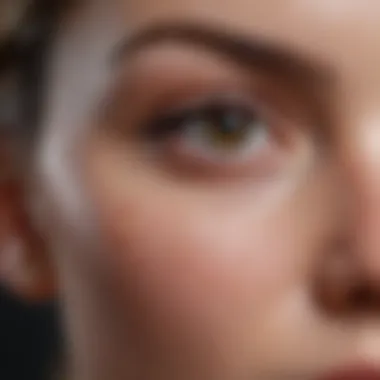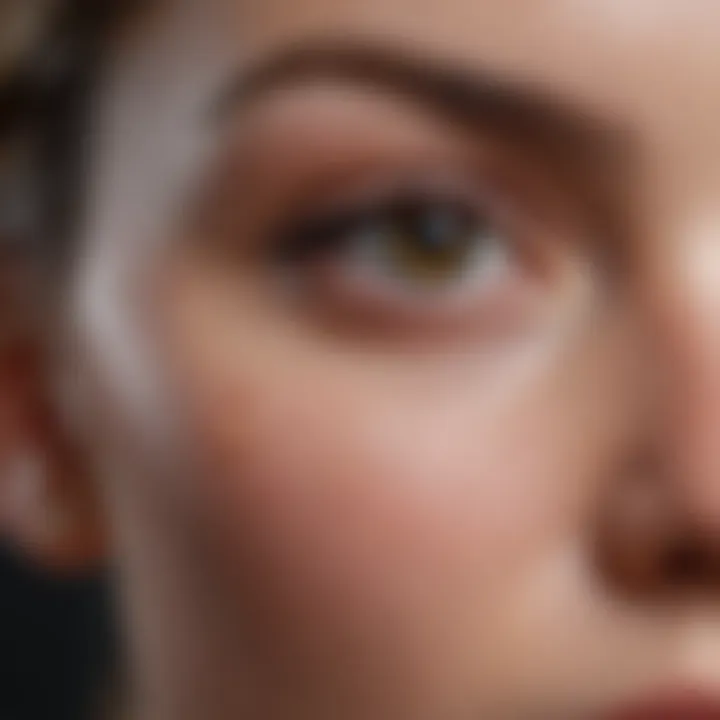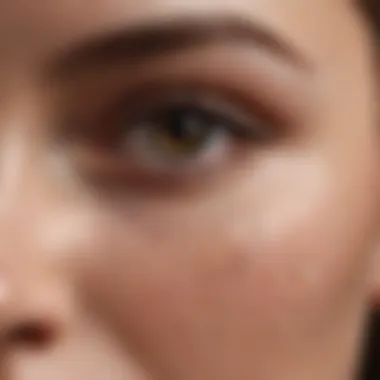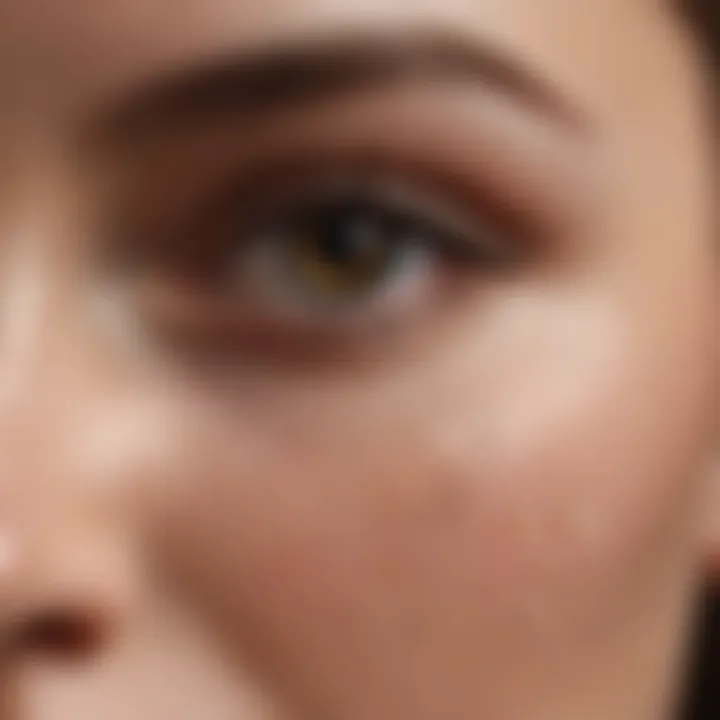The Comprehensive Guide to Eye Cream for Dark Puffy Eyes


Intro
Dark circles and puffiness around the eyes are common concerns for many individuals. These issues can arise from various factors, such as lack of sleep, stress, and even genetics. As a result, eye creams designed to combat these problems have gained significant popularity. The efficacy of these products often depends on their ingredients and how they align with individual needs. This guide aims to unravel the complexities surrounding dark puffy eyes and provide a detailed understanding of eye creams that effectively target these issues.
In this article, we will explore the causes of dark circles and puffiness, the active ingredients that can help alleviate these conditions, and practical advice on applying eye creams. Additionally, lifestyle changes that can enhance the results of these creams will be discussed. By the end, readers should gain a comprehensive knowledge of selecting suitable eye creams for their specific concerns.
Beauty Tips and Tricks
Skincare Routine Tips
To effectively manage dark circles and puffiness, incorporating a dedicated skincare routine is essential. Start with a gentle cleanser to remove impurities. Follow with a hydrating toner to prepare the skin for subsequent products. An effective eye cream should be applied next, focusing on the delicate skin around the eyes.
Here are some key tips for layering your skincare products:
- Always apply eye cream before heavier moisturizers to ensure better absorption.
- Use your ring finger to apply eye cream; it applies the least amount of pressure.
- Consider the temperature of your products. Cold creams can help reduce puffiness instantly.
Haircare Hacks
While primarily focusing on eye care, consider that overall grooming contributes to a refreshed appearance. Opt for hairstyles that draw attention from your eye area. For example, updos or hairstyles with texture may help provide a lifted look around the face. Additionally, a good set of bangs can distract from shadows under the eyes.
Makeup Application Techniques
Makeup can also assist in concealing dark circles. Using a color corrector can neutralize darker tones. A peach or orange tone works well for fair skin, while deeper skin tones may benefit from richer hues. After correcting, use a lightweight concealer that matches your foundation for a seamless blend. Remember to set the makeup lightly, as heavy powders can exacerbate the appearance of fine lines.
Expert Beauty Advice
Professional Makeup Artist Insights
Makeup artists suggest that less is more when covering dark circles. Overapplying product can lead to a cakey finish. Instead, build the coverage gradually and focus on the inner corners of the eyes to brighten the look.
Skincare Specialist Recommendations
Skin specialists emphasize the importance of choosing eye creams with specific active ingredients such as caffeine, hyaluronic acid, and peptides. These ingredients play a crucial role in reducing puffiness and improving skin texture around the eyes. It's also critical to test products to observe how your skin responds, as sensitivity can lead to adverse reactions.
Hair Stylist Tips
Hair stylists often mention that hairstyle choices can complement eye care routines. A well-groomed fringe can provide symmetry and divert attention from dark circles. Using hair care products that enhance shine can also contribute to an overall more awake appearance.
Finale
Understanding how to effectively address dark and puffy eyes is key to enhancing one's beauty regimen. By implementing consistent skincare practices, employing practical beauty tips, and utilizing expert advice, individuals can significantly improve their appearance. Incorporating well-chosen eye creams into a daily routine, along with beneficial lifestyle changes, provides a holistic approach to skincare. This comprehensive understanding empowers readers to take control of their beauty choices.
Understanding Dark Puffy Eyes
Understanding dark puffy eyes is essential for anyone looking to improve their appearance and overall skincare regimen. The eyes are often considered the focal point of the face, and any discoloration or swelling in this area can attract unwanted attention. This topic covers key factors behind dark circles and puffiness, leading to informed choices about eye creams and treatments.
Dark circles and puffiness have various origins. Recognizing these factors helps in selecting the right products. Moreover, identifying underlying issues can enhance the effectiveness of the chosen treatments, ensuring a more successful skincare routine.
Defining Dark Circles
Dark circles are defined as the discoloration under the eyes, often appearing as blue or purple undertones. This can happen when blood vessels beneath the skin become more prominent. The thin skin around the eyes allows blood vessels to show through easily, resulting in a tired or aged appearance.
Various reasons contribute to dark circles, including fatigue, stress, and genetics. Moreover, certain lifestyle choices, such as inadequate sleep and unhealthy eating habits can exacerbate this condition. Addressing these issues is crucial in creating an effective eye care routine.
What Causes Puffiness?
Puffiness around the eyes is primarily attributed to the accumulation of fluid in the tissue surrounding the eyes. This can be due to several reasons, such as lack of sleep, allergies, or even excessive salt intake. Additionally, factors like dehydration and stress can lead to inflammation and swelling.


It's important to recognize how lifestyle and environmental factors impact puffiness. For example, sleeping poorly can cause fluid retention. By making changes in these areas, one can potentially reduce the occurrence of puffiness. Understanding these causative factors can help in targeting the issue precisely.
Genetic Factors in Dark Circles
Genetics play a significant role in determining how likely someone is to develop dark circles. If a family member carries this trait, it may be passed down. Conditions such as thin skin, hollowness under the eyes, and the tendency to develop pigmentation can be inherited.
Moreover, individuals with darker skin tones are more prone to hyperpigmentation, which can also lead to dark circles. Recognizing genetic predisposition allows for better-informed choices in selecting and using eye creams that are most appropriate for specific skin types.
The Role of Aging
Aging has a profound impact on the skin, particularly around the eyes. Over time, skin loses collagen and elastin, leading to thinner skin and a more pronounced appearance of dark circles. Additionally, fat around the eyes may diminish, which causes a hollowed look and further emphasizes discoloration.
As people age, fluid retention may also increase, resulting in puffiness. Awareness of these natural changes can prompt proactive measures, such as using targeted eye creams that contain effective ingredients to combat the visible signs of aging. Recognizing the role of aging prepares readers for a realistic approach to skin care.
The Science of Eye Creams
Eye creams are often marketed as elusive solutions to stubborn dark circles and puffiness that affect many individuals. Understanding the science behind these products is crucial. The efficacy of an eye cream primarily hinges on its ingredients. Each component is purposefully selected to target specific concerns associated with the delicate skin around the eyes. This area is particularly thin and susceptible to various factors that contribute to unsightly appearances.
Key Ingredients in Eye Creams
Peptides
Peptides are small chains of amino acids that play an essential role in skin repair and renewal. Their contribution lies in stimulating collagen production, which can help restore skin elasticity. These qualities make peptides a popular choice in eye creams aimed at reducing signs of aging. Notably, peptides can help with moisture retention and overall skin texture. Due to their effectiveness, they are often included in formulations targeting puffy eyes.
Retinol
Retinol, a derivative of vitamin A, is renowned for its ability to promote cell turnover. This characteristic helps in reducing pigmentation and smoothing the skin, making it an ideal component in eye creams. Retinol can help minimize the appearance of dark circles and enhance skin tone. However, one must be cautious, as retinol can cause irritation, especially for sensitive skin types. Pinpointing the right concentration is crucial for effectiveness without adverse effects.
Hyaluronic Acid
Hyaluronic Acid is a powerful humectant, meaning it draws moisture from the environment into the skin. Its hydrating properties are invaluable for maintaining skin plumpness and reducing the appearance of fine lines around the eyes. This ingredient is particularly beneficial for anyone experiencing dryness. The unique feature of Hyaluronic Acid is its ability to hold multiple times its weight in water, making it a vital ingredient for effective hydration. It generally boasts very few disadvantages, making it a universal choice in many skincare products.
Caffeine
Caffeine is not just a morning beverage; it also has significant benefits for the skin. In eye creams, caffeine helps to constrict blood vessels, which can reduce puffiness and dark circles. Its antioxidant properties protect the skin from environmental stressors, contributing to a more youthful appearance. The unique advantage of caffeine is its quick action, providing immediate results, which is why it’s often favored for products targeting tired eyes.
Amino Acids
Amino acids are the building blocks of proteins, including collagen and elastin. In eye creams, they play a vital role in skin repair and protection. Their ability to enhance skin texture and hydration makes them an essential addition. Due to their versatility, amino acids can cater to various skin types and concerns. However, their effectiveness largely depends on the formulation, which can vary from one brand to another, leading to mixed results.
How Ingredients Work
Understanding how these ingredients interact with the skin is essential for making informed choices. The success of an eye cream derives from a synergistic blend of these active components. Each ingredient brings unique benefits that collectively address issues of dark circles and puffiness. When choosing an eye cream, it’s vital to consider the specific needs of your skin, and how these ingredients can cater to those needs. Moreover, it’s advisable to patch-test any product, especially those with potentially irritating components like retinol. The right eye cream can significantly enhance your overall regimen, providing the much desired improvement in skin appearance.
Choosing the Right Eye Cream
Choosing the right eye cream is a critical step in addressing dark circles and puffiness. As the skin around the eyes is particularly delicate, selecting a product that meets individual needs is crucial. Not all eye creams are formulated the same way, and understanding key factors can lead to better results. Moreover, the correct choice can enhance overall skincare routines, offering targeted benefits that can refresh and rejuvenate the eye area.
Reading Labels Effectively
When it comes to eye creams, labeling is key. Understanding ingredients on the label can help in selecting a suitable product. The first step is to look for active ingredients known for fighting dark circles and puffiness. For instance, caffeine can constrict blood vessels, reducing the appearance of puffiness. In contrast, hyaluronic acid can hydrate and plump the skin, improving texture and elasticity.
Avoid products with irritating chemicals like artificial fragrances and dyes. These additives can cause sensitivity, especially for those with delicate skin around the eyes. Always look for hypoallergenic labels, which indicate that the product is less likely to cause allergic reactions.
Identifying Your Skin Type
Identifying one's skin type is fundamental in choosing an appropriate eye cream. Skin can be categorized as oily, dry, combination, or sensitive. For instance, if an individual has oily skin, they may lean toward lighter formulas that won't exacerbate oiliness. Conversely, those with dry skin will benefit from richer creams that provide deep hydration.
Additionally, it is essential to consider specific concerns. If redness is a significant issue, look for soothing ingredients such as chamomile or aloe vera that can calm irritation. Tailoring the product to one’s unique skin type ensures that it addresses specific needs effectively.


Evaluating Brand Reputation
Brand reputation plays a significant role in product selection. Well-established brands often have a history of efficacy and safety, backed by research and customer feedback. When evaluating a brand, consider their commitment to quality. Look for brands that avoid harsh chemicals and prioritize natural ingredients. Assess consumer reviews and ratings, as they can provide insights into user experiences and product effectiveness.
It may also be beneficial to consider brands that have dermatologists’ endorsements or clinical studies supporting their claims. This not only adds a layer of trust but also indicates a commitment to research in skincare.
"Selecting the right eye cream is not just about addressing existing conditions, but also about investing in long-term skin health."
Applying Eye Creams Correctly
Applying eye creams correctly is a pivotal step in your skincare routine, especially when targeting dark circles and puffiness. The skin around the eyes is delicate and requires gentle handling. Using the right techniques not only enhances the effectiveness of the product but also helps in maintaining the overall health of the skin in that area.
Optimal Application Techniques
To get the most out of your eye cream, it is crucial to apply it correctly. Here are steps to follow:
- Start Clean: Begin with a clean face. Gently wash your face with a mild cleanser to remove impurities.
- Use the Right Amount: A pea-sized amount is usually enough for both eyes. Applying too much can lead to unnecessary product waste and possibly irritation.
- Dab, Don't Rub: Using your ring finger, gently tap the cream around the orbital bone. Avoid dragging or pulling the skin, as this can cause more puffiness or even fine lines over time.
- Move inwards: Apply the cream starting from the outer corner of your eye and moving inward. This method minimizes pressure on your more sensitive skin.
- Follow Up: Allow the cream to absorb before applying any other product. This waiting time can enhance the penetration of active ingredients.
By adhering to these techniques, you can significantly improve the results of your eye cream treatment. Remember that consistency and proper method are key.
Consistent Routine Importance
Consistency is paramount when incorporating eye cream into your skincare regimen. Applying eye cream sporadically will not yield visible results. Here are some reasons why sticking to a routine is important:
- Cumulative Effect: Regular use leads to cumulative benefits. Ingredients like retinol and peptides work over time to improve skin texture and tone.
- Prevention of Dark Circles and Puffiness: Daily application can help in preventing the onset of dark circles and puffiness. It is much easier to maintain healthy skin than to repair damage later.
- Boost in Confidence: Developing a skin care routine provides structure. Knowing that you are taking steps to care for your skin contributes to a sense of well-being.
"Skincare is not just a routine, it is a commitment to yourself."
Combining Eye Creams with Other Products
Combining eye creams with other skincare products can greatly enhance their efficacy. Eye creams are formulated specifically for the delicate area around the eyes, but their benefits can be magnified when used alongside complementary products. Understanding how to layer these products properly can help achieve more significant improvements in the appearance of dark circles and puffiness.
Benefits of Combining Products
When integrating eye creams with serums and moisturizers, users can target multiple skin concerns simultaneously. For example, a good serum rich in antioxidants can help brighten the skin, while a hydrating moisturizer can prevent dryness and enhance the skin's overall texture. This kind of combination works synergistically, potentially yielding faster and more visible results.
Considerations When Combining
While combining multiple products can be beneficial, it’s crucial to pay attention to certain factors. First, consider the ingredients in each product to avoid any adverse reactions. Some ingredients may not work well together or could cause irritation in sensitive skin areas. Second, the order of application matters. Generally, lighter products like serums should be applied before heavier creams to ensure proper absorption. Your skincare routine’s overall goal should be to create a balanced approach, enhancing rather than overwhelming the skin.
The Role of Serums
Serums are concentrated formulations designed to target specific skin concerns. Therefore, when it comes to their role with eye creams, serums can serve as a crucial layer in a skincare routine.
Using a serum that contains brightening agents, like vitamin C or licorice root extract, before applying eye cream can help address dark circles effectively. These active ingredients can penetrate deeper into the skin, promoting a brighter, more radiant complexion. However, care must be taken to choose a serum that is also gentle enough for the delicate eye area.
In summary, serums can offer targeted solutions that complement the hydration and soothing properties of eye creams, creating a powerful synergy for eye care.
Moisturizers and Their Impact
Moisturizers play an important role in any skincare routine, including those dealing with dark circles and puffiness. They deliver hydration and help to maintain the skin's moisture barrier. When paired with an eye cream, moisturizers can enhance the overall effectiveness of the eye treatment.
A well-formulated moisturizer can help to keep the skin around the eyes supple and plump, minimizing fine lines and preventing future puffiness. It is essential to select a moisturizer that is suitable for your skin type and that does not clog pores or cause irritation. This can also aid in the absorption of the eye cream, allowing for better results.
Lifestyle Considerations
Lifestyle plays a crucial role in the appearance of dark puffy eyes. While eye creams can help alleviate symptoms, underlying lifestyle factors must also be considered to achieve desirable results. By focusing on these elements, one can significantly enhance the effectiveness of any skincare product.
Dietary Factors
Diet has a direct impact on skin health. Consuming a balanced diet rich in vitamins and minerals can support skin vitality. Key nutrients include vitamin C, which aids collagen production; vitamin K, known for its role in reducing dark circles; and antioxidants, which protect the skin from damage. Additionally, avoiding excessive salt intake can prevent water retention, which often leads to puffiness. Integrating fruits, vegetables, and healthy fats, such as avocados and nuts, can contribute positively to the skin's appearance.


Importance of Sleep
Adequate sleep is essential for overall health and significantly affects the skin's condition. When one doesn’t get enough sleep, the skin can appear dull and tired. The eyes, in particular, reflect lack of rest with dark circles and puffiness. Experts recommend aiming for seven to nine hours of uninterrupted sleep each night. Furthermore, establishing a relaxing bedtime routine can help improve sleep quality, indirectly impacting the beauty regimen by reducing eye-related issues.
Hydration's Role
Proper hydration is fundamental for maintaining skin elasticity and reducing appearance of puffiness. Dehydrated skin can lead to dark circles and accentuate fine lines. Drinking sufficient water throughout the day is essential. It is recommended to drink at least eight 8-ounce glasses of water daily, though individual needs may vary. Additionally, consuming hydrating foods like cucumbers and watermelon can also support overall skin hydration.
Maintaining a well-rounded lifestyle is not only beneficial for overall health but is essential for addressing dark puffy eyes.
Product Recommendations
Selecting the right eye cream is vital for effectively addressing dark circles and puffiness. Eye creams come in various formulas, each targeting specific concerns. The right product can significantly improve the appearance of the delicate skin around the eyes.
Top Eye Creams on the Market
When considering options, it is important to evaluate product effectiveness and ingredients. Some top eye creams include:
- Kiehl's Creamy Eye Treatment with Avocado: This is known for its rich texture, providing deep hydration while reducing dark circles.
- Estée Lauder Advanced Night Repair Eye Supercharged Complex: This cream includes powerful antioxidants, helping to firm and brighten the eye area.
- Olay Eyes Brightening Eye Cream: It contains caffeine and Vitamin C to visibly reduce puffiness and dark circles.
These creams are highly regarded for their results and user satisfaction and are suited for various skin types.
Budget-Friendly Options
Affordability does not equate to a lack of effectiveness. There are excellent budget options that deliver benefits without breaking the bank. Consider:
- CeraVe Eye Repair Cream: This product includes essential ceramides and hyaluronic acid, making it effective for hydration and restoring skin barriers.
- Neutrogena Hydro Boost Eye Gel-Cream: This has a lightweight formula and provides lasting hydration with hyaluronic acid.
- The Ordinary Caffeine Solution 5% + EGCG: This is a powerful solution specifically designed to reduce the appearance of dark circles.
These budget options may fit well into a beauty regimen, providing value and efficacy.
Luxury Brands Worth Investing In
Luxury eye creams often contain premium ingredients that enhance performance. Though they come at a higher price, they may offer significant benefits. Some recommended luxury brands include:
- La Mer The Eye Concentrate: This is known for its potent formula, which helps visibly reduce dark circles and puffiness while nourishing the skin.
- SK-II R.N.A. Power Eye Cream: Renowned for its advanced molecular technology that hydrates and firms the skin around the eyes effectively.
- Chanel Le Lift Firming Anti-Wrinkle Eye Cream: This cream focuses on lifting and smoothing while providing excellent hydration.
Investing in these products could lead to remarkable improvements in the health of the skin around the eyes.
"Choosing the right eye cream tailored to your unique needs can make a substantial difference in how you manage dark circles and puffiness."
With a better view of the market, consumers can make informed choices about eye creams, leading to effective results.
Finale
The conclusion serves as a critical component of this article by encapsulating the insights shared across various sections. As we have explored, dark circles and puffiness under the eyes are common concerns for many individuals. Addressing these issues effectively requires more than just choosing an eye cream; it requires understanding how different ingredients work, learning proper application techniques, and acknowledging the role of lifestyle factors in skin health.
In our guide, we discussed how key ingredients like peptides, retinol, and caffeine contribute to the reduction of visible signs of aging and fatigue. A well-chosen eye cream can significantly improve the appearance of the delicate skin around the eyes, but only if it is applied consistently and correctly. It is also crucial to consider one’s skin type and the reputation of the product brands when selecting an eye cream.
Moreover, making informed choices extends beyond the product itself. Incorporating healthy habits—like maintaining proper hydration and sleep—can enhance the effectiveness of an eye cream. This holistic approach to skincare not only addresses the symptoms of dark and puffy eyes but also promotes overall skin health.
"A comprehensive understanding of eye creams can empower you to make choices that suit your skincare needs best."
Ultimately, this article aimed to provide beauty enthusiasts, makeup lovers, and skincare aficionados with the knowledge they need to combat dark and puffy eyes effectively, enhancing their overall beauty regimen. By synthesizing this knowledge, you can navigate the myriad of options available in today’s market with greater confidence.
Summarizing Key Takeaways
- Understanding Causes: Recognizing the underlying causes of dark circles and puffiness can assist in selecting suitable products.
- Ingredient Knowledge: Familiarity with active ingredients in eye creams, such as hyaluronic acid and caffeine, is essential for targeted results.
- Application Matters: The way eye creams are applied affects their efficacy; gentle tapping techniques are recommended.
- Lifestyle Impact: Diet, sleep, and hydration all factor into the appearance of under-eye areas, reinforcing the importance of a holistic approach.
- Product Selection: Choose products based on personal skin types and brand reputation to ensure desired outcomes.
Encouraging Informed Choices
Making informed choices about eye creams involves a combination of education and personal awareness. Here are critical aspects to consider:
- Research and Reviews: Look for reviews and studies that validate the effectiveness of the products before making a purchase. Websites like Reddit and beauty-focused platforms can provide real user experiences.
- Consultation: If uncertain, consulting with a dermatologist can help identify the right ingredients and products tailored for your skin needs.
- Patch Testing: Always perform a patch test before fully incorporating a new eye cream into your routine to prevent allergic reactions.
- Stay Updated: The beauty industry is constantly evolving. Keeping abreast of new scientific findings and product launches can help you make better choices.
In summary, the knowledge gained from this guide equips you not just to choose an eye cream but to understand its role within a broader skincare routine. Crafting your path to healthier, more vibrant skin is a journey that incorporates knowledge, product choice, and personal care.







